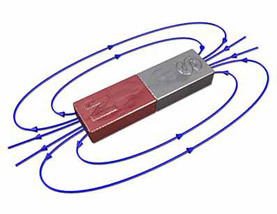
Field lines of a permanent magnet go from north to south.
Permanent magnets are materials where the magnetic field is generated by the internal structure of the material itself.
Inside atoms and crystals you have both electrons and the nucleus of the atom. Both the nucleus and the electrons themselves act like little magnets, like little spinning chunks of electric charge, and they have magnetic fields inherent in the particles themselves. There's also a magnetic field that's generated by the orbits of the electrons as they move about the nucleus. So the magnetic fields of permanent magnets are the sums of the nuclear spins, the electron spins and the orbits of the electrons themselves.
In many materials, the magnetic fields are pointing in all sorts of random directions and cancel each other out and there's no permanent magnetism. But in certain materials, called ferromagnets, all the spins and the orbits of the electrons will line up, causing the materials to become magnetic. This would be your normal iron, cobalt, nickel.
Permanent magnets are limited by the structure of the material. And the strongest magnetic field of a permanent magnet is about 8,000 gauss. The strongest magnets here at the Magnet Lab are 450,000 gauss, which would be almost 50 times stronger than that.


